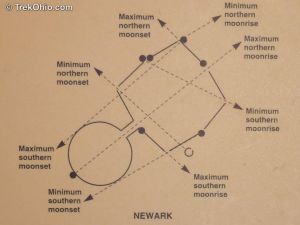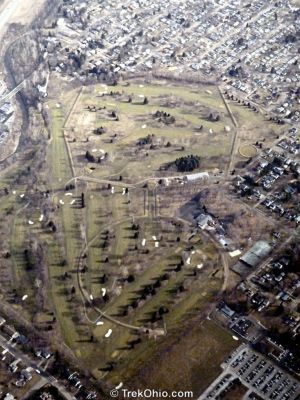Mississippi Mounds: Difference between revisions
mNo edit summary |
mNo edit summary |
||
| (8 intermediate revisions by 2 users not shown) | |||
| Line 1: | Line 1: | ||
Peoples of the Mississippi basin, across a dozen millennia, have constructed thousands of mounds from the flood loam of the [[Mississippi River]] and her tributaries. These earthworks likely served several purposes, used variously as temple, effigy, fortress, and observatory. They contain burials, funerary objects and iconographic artifacts. | |||
The mounds consist of rich humus in agricultural lowlands. | |||
Many descendants of the Mississippian culture view the mounds as sacred, and some tribes perform ceremonies at the ancient mounds to this day. Since the founding of the [[United States]], settlers have been destroying them in the name of "development" (often [[farmland]] or [[deathways|highway]]), while collectors + archaeologists loot their "specimens". | |||
Five of the largest mounds—the Great Circle Earthworks, Octagon Earthworks, [[Serpent Mound]], Alligator Mound and [[Cahokia Mounds]]—had to weather centuries of abuse to have the modicum of protection and respect they receive today. | Five of the largest mounds—the Great Circle Earthworks, Octagon Earthworks, [[Serpent Mound]], Alligator Mound and [[Cahokia Mounds]]—had to weather centuries of abuse to have the modicum of protection and respect they receive today. | ||
<ref>Sacred Land Film Project, "Mississippi Mounds" by Amy Corbin (updated: 21 April 2021) https://sacredland.org/mississippi-mounds-united-states/</ref> | <ref name = "Sacred Land Film Project">Sacred Land Film Project, "Mississippi Mounds" by Amy Corbin (updated: 21 April 2021) https://sacredland.org/mississippi-mounds-united-states/</ref> | ||
=Octagon= | |||
[[File:Octagon_mound_astrolabe.jpeg|thumb|]] | |||
[[File:Octagon_mound_modern.jpeg|thumb|]] | |||
The Ohio Historical Society (OHS), which receives 70% of its operational funds from the State of Ohio, is the deed holder of the Octagon Mound. The OHS leases the land to Moundbuilder's Country Club for $7,000 a year. The country club advertises their colonial hold on the land on their website, "The golf course at Moundbuilders is unlike any other in the world. It is designed around famous Prehistoric Native American Earthworks that come into play on eleven of the holes."(https://www.moundbuilderscc.com/Default.aspx?p=DynamicModule&pageid=367885&ssid=280004&vnf=1) <ref name = "Ballengee-Morris 2010">BALLENGEE-MORRIS, C. (2010). They Came, They Claimed, They Named, and We Blame: Art Education in Negotiation and Conflict. 'Studies in Art Education', 51(3), 275–287. http://www.jstor.org/stable/40650514</ref> | |||
=Serpent= | |||
== Peace Summit == | |||
In celebration of the Serpent Mound as an honored and revered place of rebirth and mystical energy, the Serpent Mound Spring Seed And Water Blessing, Music Peace Summit is held annually during the Spring Equinox at the adjacent Soaring Eagle Retreat, part of the Old Serpent Mound Farm. | |||
As a gathering of like-mind followers of ancient traditions from around the world, it is held each year to honor the equinox and time of planting. | |||
Serpent Mound is a place where seeds can be “regenerated," similar to Fort Ancient, England’s Stonehenge, Native mounds in Newark and other places. | |||
As described by one summit organizer, Thomas Johnson: “It has something to do with the sun and the earth’s energy, and the position of the earth at that time of year. We place seeds on the mound for a few hours, people take them home and plant them, and for some reason they do better.”<ref>https://www.timesgazette.com/2019/02/15/honoring-serpent-mound/</ref> | |||
Although not many local people attend the event, Native peoples come from across the country and visitors come from around the world. | |||
=== 2019 === | |||
"The event will also honor the spring equinox by bringing together delegations from the Americas and all around the world to talk and pray, about and for, international peace. Its message is: ‘It takes a village, all nations, all races, all my relations.'" | |||
"Visitors may bring their seeds as they will not only get the benefit of the sound vibration, but also be will be blessed at the mound by the Friends of Serpent Mound... It will be these seeds that will be planted by the people; the pollen from the flowers will be carried by the bees and wind all over the world. The power of these seeds is the power of creation, the planting of a new world of peace. The peace summit was gifted a peace pole by Chief Golden Light Eagle which was made by the late Chief Blue Star Eagle. The community will join in praying for peace as the peace pole brings light and carries good intentions for all the world.”<ref>https://www.timesgazette.com/2019/02/15/honoring-serpent-mound/</ref> | |||
=== 2023 === | |||
https://www.eventbrite.com/e/serpent-moundstar-knowledge-spring-equinox-peace-summit-tickets-449620074747 | |||
=Cahokia= | |||
=Sources= | |||
Latest revision as of 02:14, 22 June 2023
Peoples of the Mississippi basin, across a dozen millennia, have constructed thousands of mounds from the flood loam of the Mississippi River and her tributaries. These earthworks likely served several purposes, used variously as temple, effigy, fortress, and observatory. They contain burials, funerary objects and iconographic artifacts.
The mounds consist of rich humus in agricultural lowlands.
Many descendants of the Mississippian culture view the mounds as sacred, and some tribes perform ceremonies at the ancient mounds to this day. Since the founding of the United States, settlers have been destroying them in the name of "development" (often farmland or highway), while collectors + archaeologists loot their "specimens".
Five of the largest mounds—the Great Circle Earthworks, Octagon Earthworks, Serpent Mound, Alligator Mound and Cahokia Mounds—had to weather centuries of abuse to have the modicum of protection and respect they receive today.
Octagon
The Ohio Historical Society (OHS), which receives 70% of its operational funds from the State of Ohio, is the deed holder of the Octagon Mound. The OHS leases the land to Moundbuilder's Country Club for $7,000 a year. The country club advertises their colonial hold on the land on their website, "The golf course at Moundbuilders is unlike any other in the world. It is designed around famous Prehistoric Native American Earthworks that come into play on eleven of the holes."(https://www.moundbuilderscc.com/Default.aspx?p=DynamicModule&pageid=367885&ssid=280004&vnf=1) [2]
Serpent
Peace Summit
In celebration of the Serpent Mound as an honored and revered place of rebirth and mystical energy, the Serpent Mound Spring Seed And Water Blessing, Music Peace Summit is held annually during the Spring Equinox at the adjacent Soaring Eagle Retreat, part of the Old Serpent Mound Farm.
As a gathering of like-mind followers of ancient traditions from around the world, it is held each year to honor the equinox and time of planting.
Serpent Mound is a place where seeds can be “regenerated," similar to Fort Ancient, England’s Stonehenge, Native mounds in Newark and other places.
As described by one summit organizer, Thomas Johnson: “It has something to do with the sun and the earth’s energy, and the position of the earth at that time of year. We place seeds on the mound for a few hours, people take them home and plant them, and for some reason they do better.”[3]
Although not many local people attend the event, Native peoples come from across the country and visitors come from around the world.
2019
"The event will also honor the spring equinox by bringing together delegations from the Americas and all around the world to talk and pray, about and for, international peace. Its message is: ‘It takes a village, all nations, all races, all my relations.'"
"Visitors may bring their seeds as they will not only get the benefit of the sound vibration, but also be will be blessed at the mound by the Friends of Serpent Mound... It will be these seeds that will be planted by the people; the pollen from the flowers will be carried by the bees and wind all over the world. The power of these seeds is the power of creation, the planting of a new world of peace. The peace summit was gifted a peace pole by Chief Golden Light Eagle which was made by the late Chief Blue Star Eagle. The community will join in praying for peace as the peace pole brings light and carries good intentions for all the world.”[4]
2023
Cahokia
Sources
- ↑ Sacred Land Film Project, "Mississippi Mounds" by Amy Corbin (updated: 21 April 2021) https://sacredland.org/mississippi-mounds-united-states/
- ↑ BALLENGEE-MORRIS, C. (2010). They Came, They Claimed, They Named, and We Blame: Art Education in Negotiation and Conflict. 'Studies in Art Education', 51(3), 275–287. http://www.jstor.org/stable/40650514
- ↑ https://www.timesgazette.com/2019/02/15/honoring-serpent-mound/
- ↑ https://www.timesgazette.com/2019/02/15/honoring-serpent-mound/

